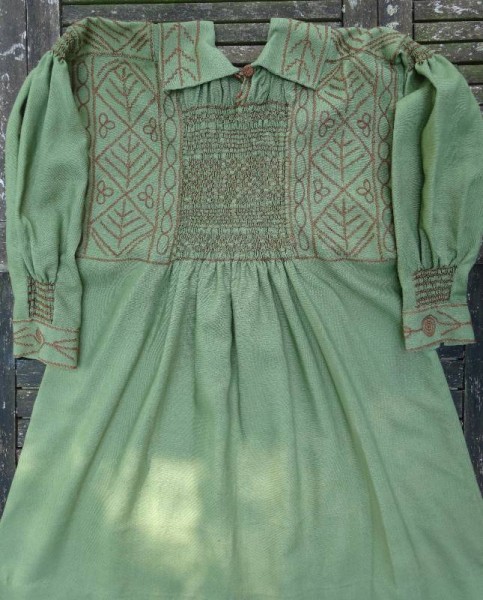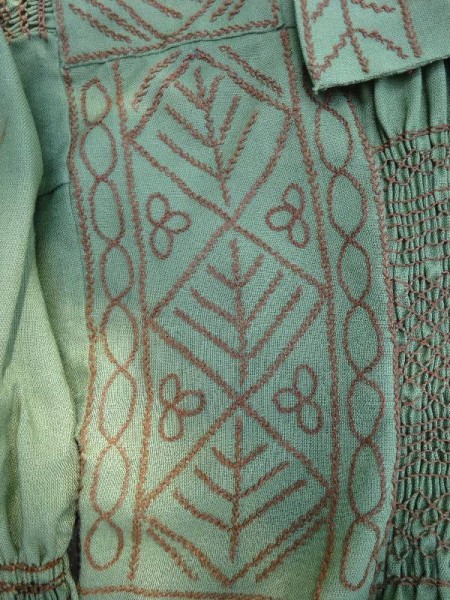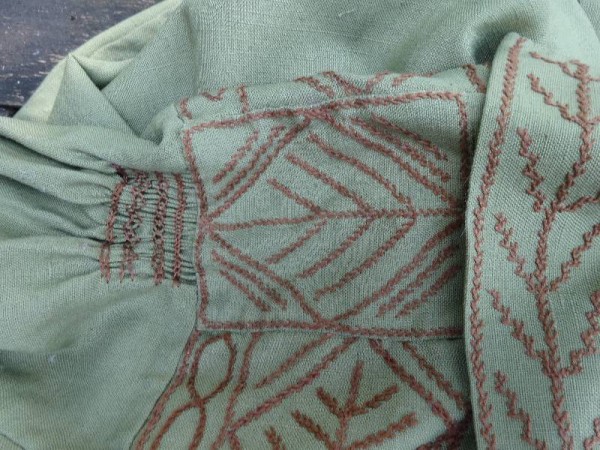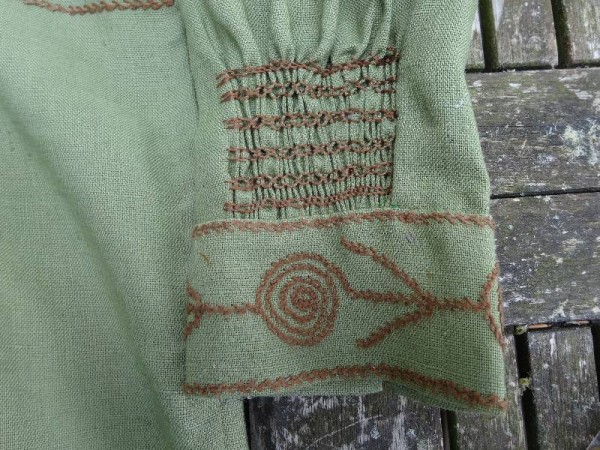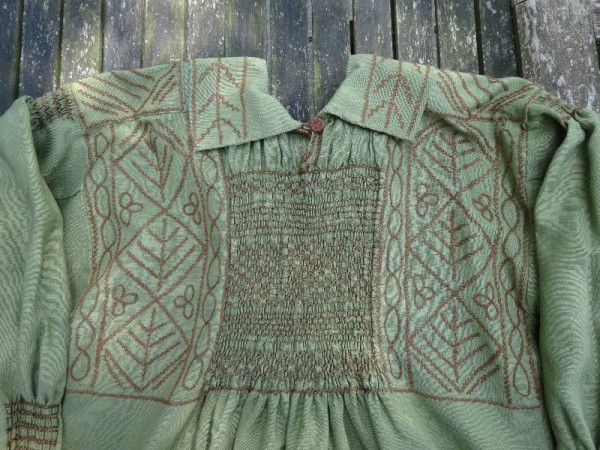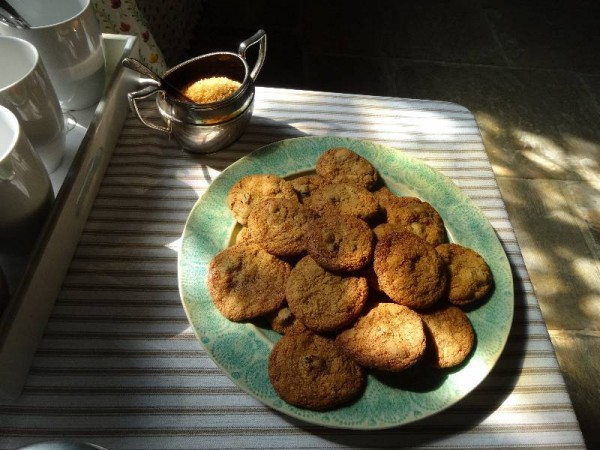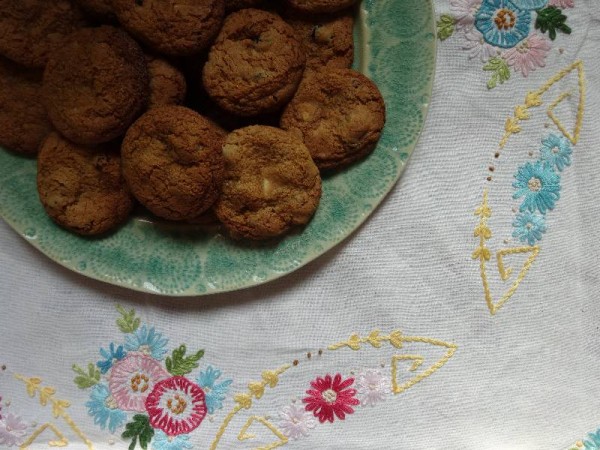This splendid traditional smock had been in temporary residence in the village costume wardrobe after its starring role on Peter Pan in a recent village pantomime. (The village costume wardrobe is a very impressively fitted out room at the back of the village hall – everything is labelled and on hangers or in boxes – thanks to the industry of those in the village handy with carpenter’s tools and the organisation of those good at keeping things in order.)
A woodman’s smock of traditional design, it was commissioned by Winwood Reade from Mrs Andrews of Dorset – as an informative label pinned to it tells me. (I said the village was organised.) I have no idea why she commissioned it but I suspect it was more out of interest in keeping a craft alive rather than because Winwood needed one for her woodman. I have also drawn a blank with Mrs Andrews, so if anyone knows anything, please get in touch. In the past, such smocks would have been worn both at hiring fairs as a visible declaration of the wearer’s trade and also on the job when at work in the woods. For more about smocks and the significance of the embroidered symbols of trade, see here (towards the end of the post).
The Reade family have lived in the area around Ipsden and Checkendon since medieval times and are still very active in the community. Members of the family have lived in C17th Ipsden House since at least the early C19th (possibly before) and they also occupy Ipsden Farm which is itself remarkable for the spectacular and unusually large C18th oak-framed brick barn (24 bays and 5 entrance porches in an ‘L’ shape + shelter shed on a third side; Grade II listed, it is the site of village musical evenings and hosted the recent Jubilee celebration). Nearby there is also a staddle granary of a similar date, also Grade II listed. Members of those known loosely as the Bloomsbury Group were frequent visitors to the house in the early C20th when Dora Carrington painted doors (I think – must check) in her inimitable style. From 1930-39, Ipsden House was rented out to the novelist Rosamund Lehmann.
In the C19th Charles Reade was famous for his books denouncing social injustices. Today he is best known for his historical novel ‘The Cloister and the Hearth’ which describes the emotional turmoil undergone by the father of the scholar Erasmus as he battles religious celibacy against human love. Erasmus was illegitimate; his father became a monk. After his his parents’ deaths his guardians made him enter an Augustinian monastery which experience led to him becoming a lifelong critic of monasteries and the monastic life. George Orwell cuttingly commented that Reade was only read for the charm of useless knowledge, which on the surface – albeit given my limited knowledge of the man – seems a bit unjust.
Charles Reade was certainly an eccentric with a style of shabby dress closer to that of a down and out than a landowner. The wife of the painter Millais told an amusing story about Charles who presented himself one evening at the Millais household and on the doorstep insisted that he must have her husband’s recent painting ‘The Knight Crossing the Ford’. Thinking him to be a tramp, she gently tried to get rid of him but with a twinkle in his eye he retorted, “Oh, beautiful dragon! I am Charles Reade, who wrote Never Too Late to Mend (which dealt with the conditions in prisons) and I simply must have that picture, though I am but a poor man. I would write a whole three-volume novel on it, and then have sentiment enough to spare. I only wish I had someone like you to guard my house!” Reade got the picture and Millais was apparently pleased that he should have it. I can find no mention of the price paid and whether his pleading poverty paid off.
Another Reade of note was Winwood Reade (1838-1875) who was Charles’s nephew. An African explorer, he travelled extensively to previously unknown parts of the continent but he would be little remembered for these experiences had it not been for the detailed letters he sent back to Charles Darwin. (Somewhat incredibly, it is said that he left his notebooks and equipment behind when he set off on the expedition, in which case you wonder how he found paper and pen to write to Darwin but let’s not let a few facts get in the way of a good story). Darwin drew on this information for his own book, ‘The Descent of Man’ (1871) and today the letters are available through the Darwin Correspondence Project. Winwood’s own book The Martyrdom of Man, an essay in Universal History’ (also 1871) is a wide ranging book encompassing war, religion, liberty, and intellect and although without the stature of Darwin’s books it was held in high regard (for different reasons) by Cecil Rhodes, H.G.Wells and Winston Churchill, among others. In ‘The Sign of the Four’, Sherlock Holmes urges Dr Watson to read the book. On the other hand William Gladstone (Prime Minister) thought it a rotten book and denounced it for its irreligiosity.
Winwood was obviously a family name and we next hear of it as the name of the woman born in 1917 who commissioned the smock. She worked for the famous BBC Natural History Unit in Bristol and was a producer on the popular children’s programme, Animal Magic (see interesting Guardian article) which those of us over a certain age will remember well. (The theme tune bobbles its way through my head with the very mention of the programme title and along with it comes the avuncular figure of Johnny Morris who in zookeeper uniform proceeded to anthropomorphise any and every annimal he came across in the course of half an hour. I remember it being a charming notion until suddenly I was of an age when I found it appalling – you either loved or loathed it, there was no middle ground.) But nevertheless, well done Winwood on the production values, which were I’m sure much more challenging than it all appeared to me on the other side of a 9 inch Bush bakelite televison set.
Incidentally, in the village pantomime when the smock last had an outing, it was worn by a member of the Reade family who was herself playing Peter Pan.
Postscript 15 August
Fascinating post this week on country smocks by Elizabeth Baer who knows more about antique linen and similar ancient and beautiful textiles than all of us put together may ever learn in multiple lifetimes. Her blog is an excellent read with lots of practical hints on the buying of and caring for linens of age and character.

